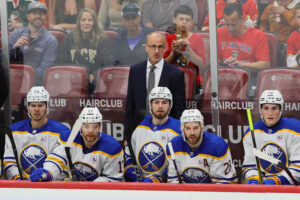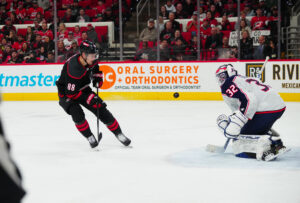The Franchise Best Series comes to you to dive into the all-time best single season for every organization. This, of course, includes post-season results. Join us for a look back at some of the most memorable moments in each franchise’s history. Here is the Buffalo Sabres best season.
The Buffalo Sabres 1974-75 season was one of only two times where the team made the Stanley Cup Final. They lost both times. In the 74-75 season, the Philadelphia Flyers were the team to bring them down, after a decisive 4-2 series. Still, the team the Sabres brought to the finals wasn’t one to shake snakes at. Their top three scorers combined for 201 points during the regular season and another 43 in the playoffs.
Their insane ability to score, mixed with a very strong goalie staff and a good amount of drama, makes them one of the best teams in New York history; and easily the best in Sabres history.
Buffalo Sabres Best Season
Previous Off-Season Additions
For what the 1974 summer had to offer, the Sabres remained fairly stagnant. Their biggest off-season addition was Danny Gare, who they drafted with the 29 overall pick in the 1974 NHL Draft. Gare became a very solid piece of the Sabres offense. In the following year, he ranked eighth on the team in points, becoming one of nine Sabres players to score more than 50 points. Throughout his career, Gare scored an even 500 points in 503 games as a Sabre and a total of 685 points in 827 NHL games.
The Sabres also made a small trade four days into their regular season. On October 14, they dealt team captain Gerry Meehan and Mike Robitaille to the Vancouver Canucks. In exchange, they got Jocelyn Guevremont and Bryan McSheffrey. The 1974-75 season was the last for McSheffrey, who played minor league hockey for all but three games that season. Guevremont, on the other hand, stuck with Buffalo for five years. In the 74-75 campaign, he established himself as a solid defenseman with 32 points. This was the fewest number of points he’d score as a Sabre until his 1978-79 season was cut short and he was only able to score 11 points.
Key Story Lines
Tim Horton‘s Death
The 1974-75 season was a dramatic one for Buffalo. 42-year-old Tim Horton, who played with Buffalo for a mere 124 games, had died the previous February in an automobile accident. The team was distraught over the death of one of their veterans. In 1996, the Sabres showed just how valuable Horton was to the organization by retiring his jersey number.
French Connection
That wasn’t the only sentiment going into the year, though. The team missed the 1974 playoffs after star center of the team’s top line, Gilbert Perreault, suffered a leg injury. This fractured their star line, titled the ‘French Connection’. This sparked the trio of Perreault, Rene Martin, and Rick Martin. They reached their peak in the 74-75 season, combining for 291 points that year alone.
They reached those totals despite Martin’s persistent hand injuries. In December, Martin suffered a thumb injury that ended the team’s current 9-0-2 winning streak. He was quick to return but suffered another injury not too much later. He was only able to play 68 games in total, the same number as Perreault recorded, but still managed 95 points. Perreault scored 96.
Danny Gare‘s Star Year
Arguably the biggest storyline of the season was that of star rookie Danny Gare. Gare scored 62 points in total during the 74-75 season, as a 20-year-old. His first NHL goal was scored only 15 seconds into his first NHL game, a feat that really laid the groundwork for both Gare’s career and the Sabres season.
Leading Scorers
The team’s leading scorer was Robert. He played the most games out of any of the ‘French Connection’ members and scored just a few more than Perreault and Martin as a result. His 100 points came from 40 goals and 60 assists. This season marked a career high in goals, assists, and total points for Robert.
This year also set a career high in points (95), goals (52), and assists (43) for Martin. Perreault’s 96 points were the third highest in his career.
In-Season Additions
In January the Sabres sent away 24-year-old Norm Gratton to the Minnesota North Stars. In return, they got Fred Stanfield. This proved to be a great deal for Buffalo. Gratton only played two more seasons in the NHL, combining 36 points in those two years. Meanwhile, Stanfield played three more years and scored a total of 115 points in Buffalo before retiring. The forward played 32 games for the Sabres in the 74-75 regular season and scored 33 points.
In March 1975, the Sabres made their second trade of the year. They dealt Garry Lariviere to the New York Islanders. In exchange, they got Gerry Desjardins, a goalie who had spent time in both the NHL and WHA. Desjardins replaced Gary Bromley for the team’s starting goalie role towards the end of the season and throughout the playoffs. He’d eventually help force Bromley out of Buffalo and into the WHA.
The two trades the Sabres made this season did a great job conveying their overall success. Both deals sent away promising young players and brought in older veterans. In both deals, the veteran ended up doing better than the player dealt away ever would.
Playoff Performers
The ‘French Connection’ didn’t disappoint in the playoffs either. Perreault and Martin both played 17 games and both tallied 15 points. Robert only played 16 and scored 13 points.
The real story of the playoffs was Gare, though. After a very exciting rookie season, Gare turned it up a notch in the playoffs. He was able to match Robert’s scoring, although he did play in one more game. Gare was never able to match the postseason scoring he had in 1975. He scored seven goals, a career high, and had six assists in the playoffs.
End Result
In the end, the Sabres were defeated by the Philadephia Flyers, a team that was notorious at the time for their physicality. Still, the overall season was easily the best in Sabres history. It seems like every player on the roster was able to contribute. In the end, they had a goal differential of 114 goals, which shows their raw ability to score. Their offensive-efficiency led them to the first-place spot in the Adams Division, and an eventual Conference title in the playoffs.
Aside from their uncanny ability to score, the Sabres also brought along a very strong goalie staff. Before injuries got the best of him, Bromley had a record of 26-11-11. Backup Roger Crozier had an even more impressive record of 17-2-1, with a save percentage of .904 and a goals-against-average of 2.62.
The 1974-75 season was flashy, too. The Sabres made a handful of risky moves, but every single one paid off. They started the year by dealing away their captain of three years. They also traded away two young prospects. Every deal seemed to help the team more and more. Whether it was luck or amazing foresight, they seemingly couldn’t bring in a player that wouldn’t produce.
Overall, the 1974-75 Sabres were one of the best teams in the history of New York hockey. They simply couldn’t be stopped once they started moving. When there were lapses in the offense, they had multiple reliable goalies to lean back on. Very few teams have had the ability to score like this team did, and very few lines have ever been as efficient as Buffalo’s ‘French Connection’ in their prime.
Main Photo:






